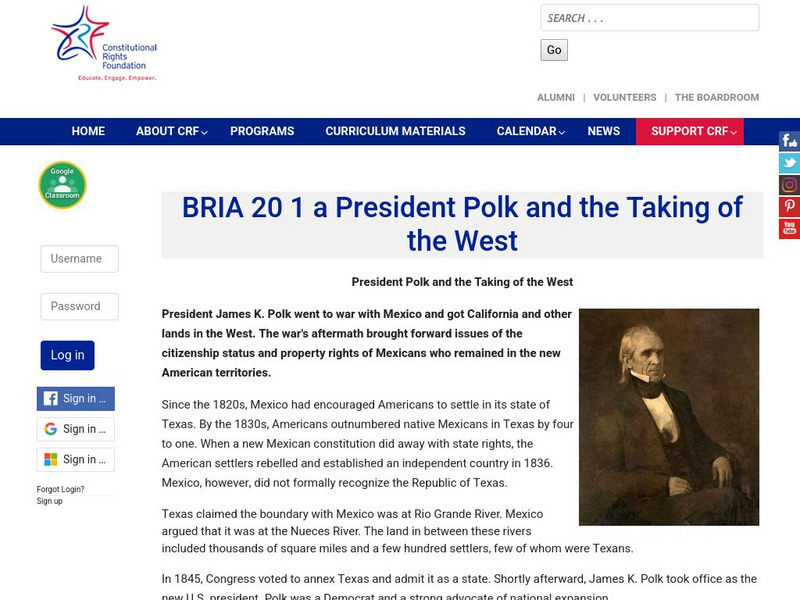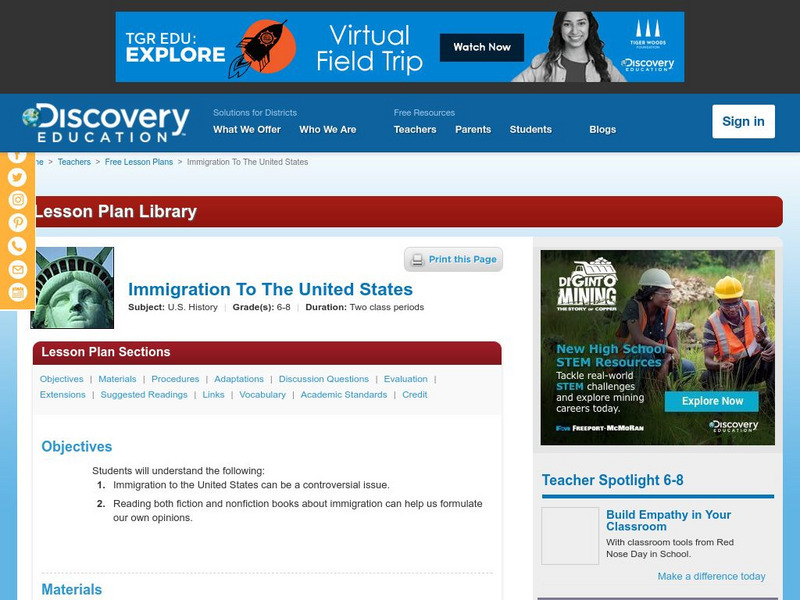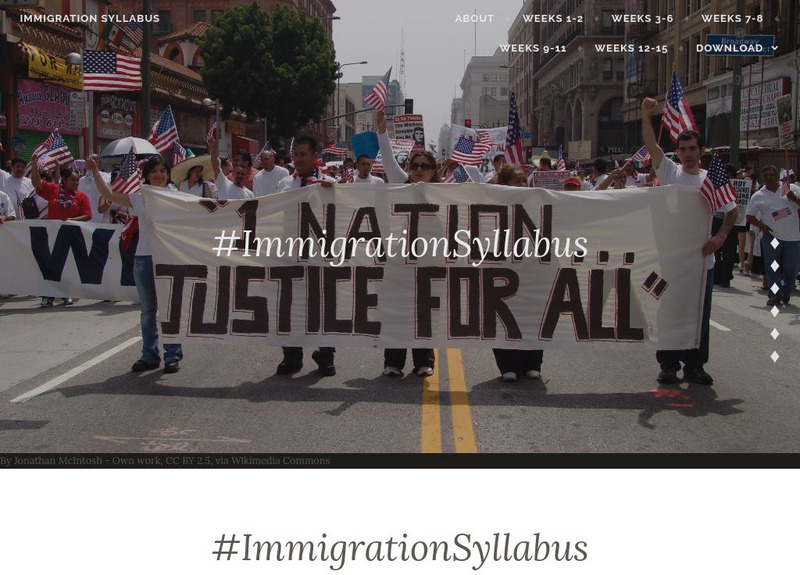Hi, what do you want to do?
Curated OER
Teacher's Guide to 2008 Presidential Election Issues: The Economy
Young scholars discuss the 2008 Presidential election. They examine the significant issues of the election and focus on the economy. Students study the major issues with the economy. Young scholars decide how they feel about each...
Curated OER
No Place Like Homelessness
Students complete a unit of activities that help them understand homelessness, its causes, and ways to better the situation. In this homelessness lesson, students complete five activities that help them to define homelessness and its...
Curated OER
Exploring Franchise and Elections
Students examine the American election process. In this elections lesson, students use Internet sources to respond to 13 questions about election terminology.
Curated OER
Then and Now: Tolerance as a Casualty of War
Students compare terrorist attacks on the US. In this lesson on tolerance and war, students use various resources and links to examine the concept of toleration during war. Students will focus on the attacks of Pear Harbor in 1941 and...
Curated OER
Segregated America
Students investigate Jim Crow laws. In this segregation lesson, students analyze images that display American segregation. Students use the provided questions to aid them in their evaluation of the images.
Curated OER
Inspiration for and Application of the Bill of Rights
Students examine individual rights. In this case law lesson plan, students discuss the from and function of the Bill of Rights prior to investigating several cases that deal with Constitutional rights. Students discuss the outcome of the...
Curated OER
That Was Then - Persuasive Essay
Student explain how geographic and cultural settings influence a person's identity. They compare and contrasting Esmeralda Santiago's Puerto Rican self with her American self by participating in a close reading of the text and writing a...
Curated OER
The Battleground: Separate and Unequal Education
Students examine the purpose and goals of education in African American society. They analyze photos, answer discussion questions, and participate in a class discussion.
Curated OER
Find the Flag
Young scholars explore the flag. In this social studies lesson, students search for flags in a picture. When young scholars locate a flag, they will read a fact about the flag, how to display it and how to care for the flag.
Curated OER
A Local History of Global Travel
Students research their families travel patterns over the last 100 years. They work with students in other countries to publish their findings. They also examine key events over the same 100 years.
Curated OER
The Battleground: Separate and Unequal Education
Learners investigate the history of unequal education in the United States and the impact on African American history. In this unequal history lesson, students discuss the purpose of education and describe an ideal school. Learners...
Curated OER
Separate is Not Equal: Brown v. Board of Education
Students analyze photographs that feature segregation. In this human rights lesson, students examine photographs of a segregated movie theater, a Ku Klux Klan gathering, a segregated business sign, and an illustration from "Harper's...
Center For Civic Education
Center for Civic Education: Constitution Day and Citizenship Day
September 17 is recognized in the United States as Constitution Day and Citizenship Day. The purpose of Constitution Day and Citizenship Day is to commemorate the creation and signing of the supreme law of the land and to honor and...
Constitutional Rights Foundation
Constitutional Rights Foundation: Conflict of Cultures: President Polk and the Taking of the West
Lesson and activity on conflict of cultures in which students study U.S. overtaking lands of Mexico and California and form policy on property rights and citizenship of conquered cultures. Activity guidelines, questions for discussion...
Alabama Learning Exchange
Alex: Happy Constitution Day
Students work in groups to create presentations answering who, what, when, where, why, and how questions concerning the U.S. Constitution. Presentations will be used to create digital Constitution Day Program.
Discovery Education
Discovery Education: Immigration to the United States
Great teacher resource for helping your students learn about immigration and why people come to the United States. Help them understand the whole immigration process and why some immigrants may have complications. Includes a glossary.
Library of Congress
Loc: A Russian Settlement in Alaska
In the early 19th century, most of the land that is now Alaska was claimed by the Russian empire, and its most significant community was Novo-Arkhangelsk, which today is called Sitka. From 1808 until the sale of Alaska to the United...
Council for Economic Education
Econ Ed Link: Rationalizing Transplants
This lesson plan encourages students to explain the consequences of a non-market rationing process, to evaluate the consequences of restricting organ transplants to U.S. citizens, and to suggest alternative policies to reduce the...
PBS
Pbs Teachers: Saudi Arabia (Lesson Plan)
In this lesson, students examine the importance of Saudi Arabia for Arabs and Muslims worldwide as well as the history of U.S.-Saudi relations. Students will identify and analyze the possible causes for terrorist acts committed inside...
PBS
Pbs Teachers: Why Celebrate Constitution Day? (Lesson Plan)
A instructional activity in understanding the significance of the U.S. Constitution revolving around an editorial that explains two modes of interpreting the constitution: "living document" versus "original intent."
University of Minnesota
University of Minnesota: Immigration Syllabus: Weeks 1 2
Week 1: Why study immigration? What does the study of immigration reveal about U.S. history and which stories we tell about ourselves as a people? Week 2: Settlers, Servants, and Slaves in British, French, and Spanish Colonial America:...
Library of Congress
Loc: Interviews With Today's Immigrants
This site, part of a larger lesson plan about immigration from the Library of Congress, provides interviews that young scholars had with immigrants from around the world.
US National Archives
Docsteach: From Dred Scott to Civil Rights Act of 1875: Eighteen Years of Change
In 1857, the U.S. Supreme Court ruled in the Dred Scott decision that African-Americans were not citizens of the United States. Yet within 18 years, Black Americans would not only have citizenship, but would be guaranteed the right to...
Other
Bringing History Home: Ww Ii Home Front
In this 5th grade unit, students study the World War II home front using primary sources. After an introduction to the origins of the war, they study the effects of the war on the U.S. economy; citizen participation in the war effort...

























